Only $99 for a full year!
No credit card required
Rank on Google's first page in 3 months
SEO Internal Linking Strategy: How It Affects Your Site Health
Jun 27, 2024 | user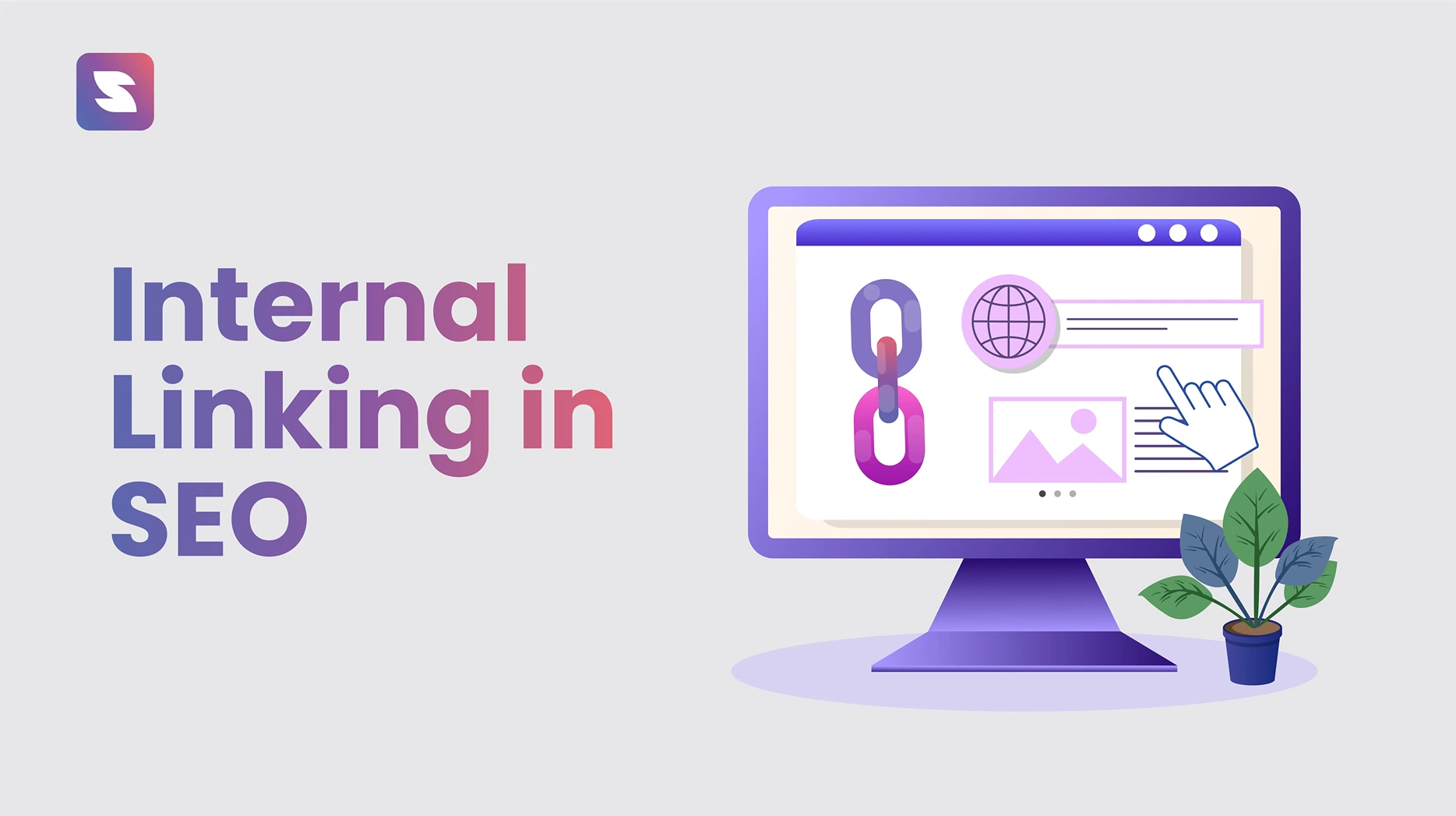
Did you know a well-executed SEO internal linking strategy can significantly boost your website’s performance?
Imagine your website’s internal links as its veins, crucial for seamless navigation and signaling how your content interconnects with search engines.

A well-structured internal linking system enhances user experience by simplifying information discovery and minimizing bounce rates.
It effectively distributes page authority across your site, thereby improving your site’s overall health and search rankings. But what does it take to create an effective SEO internal linking strategy? And which SEO tools are best suited for the task?
Check out this blog to learn about internal linking, how it benefits SEO, and the top internal linking strategy for 2024 to keep your website healthy using the best SEO tools.
What is SEO Internal Linking Strategy?
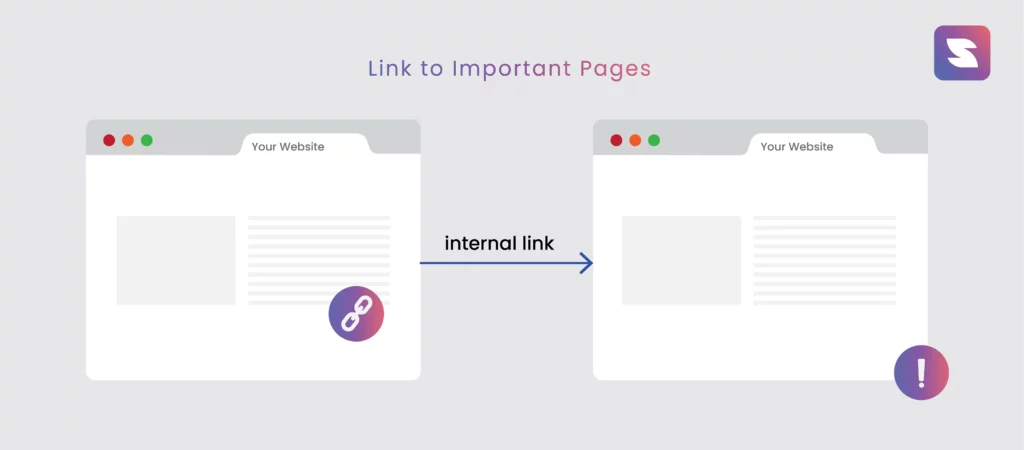
Internal link building means the practice of creating hyperlinks that connect one page of a domain to another page within the same domain. This is distinct from external linking, which involves linking to pages on different domains.
Here how an internal link will look like:

Internal linking is essential in a website for several reasons:
- Nav igation: It helps users quickly find content on your site, improving the overall user experience.
- Hierarchy and Structure: Internal links establish the architecture of your site, helping search engines understand the relative importance of pages and how they relate to each other.
- Link Juice: It refers to the value or authority one page passes to another through links. Internal linking helps distribute this value throughout your site, which can positively impact the search rankings of your pages.
Internal and external links are fundamental components of websites, but they serve different purposes. Internal links connect different pages within the same website, and external links point to pages on different websites.
Here’s a table for an easy understanding of the difference between internal and external links.
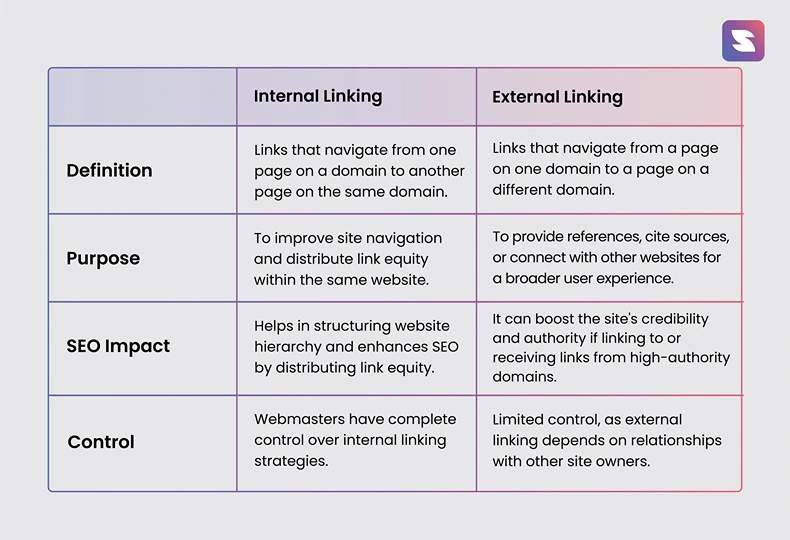
Suggested Read: Dofollow vs Nofollow Links: A Detailed Comparison
Types of Internal Links
There are several types of internal links, each serving a specific purpose in SEO and site navigation.
1. Navigational Links
These relevant links are typically found in menus, and that helps users navigate the core sections of a website. These help to cover product categories, services, or main content topics. These links are essential because they are permanently on your main menu.
It will look like this:

2. Contextual Links
These links are embedded with the body of a webpage’s content. This will be linked to other pages on your website. Contextual links are crucial for SEO as they help search engines understand the connection between different pages and the subjects they cover.
It allows users easy access to more information, further reading, or clarification on specific issues mentioned in your content. It helps increase the time the user spends on your website, giving the search engines a positive signal.
It will look like this:

3. Footer Links
These footer links appear at the bottom of every page and are used to direct visitors to reach pages on your website with the most minor importance. This includes privacy policies, terms, and conditions, sitemap, contact us, about us page, FAQ, and other reference pages.
This will look like this:
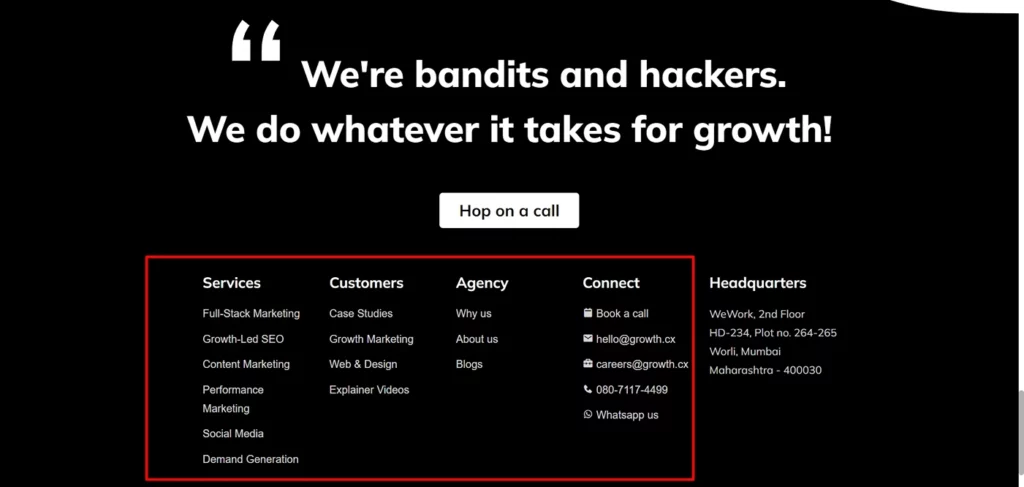
4. Sidebar Links
These links are another variety of navigational links that direct users to relevant content. They are usually positioned alongside the main content area on the left or right side. This sidebar link allows users to access various sections without scrolling back to the bottom of the page.
It will look like this:
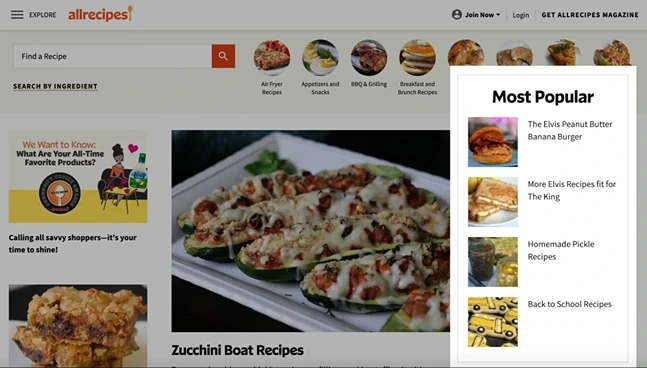
5. Breadcrumb Links
These breadcrumb links show users their current location within the website hierarchy. This will help users by providing a clear path from the page the user is viewing back to the homepage. This is at the top of a page, below the navigational bar.
It will look like this:
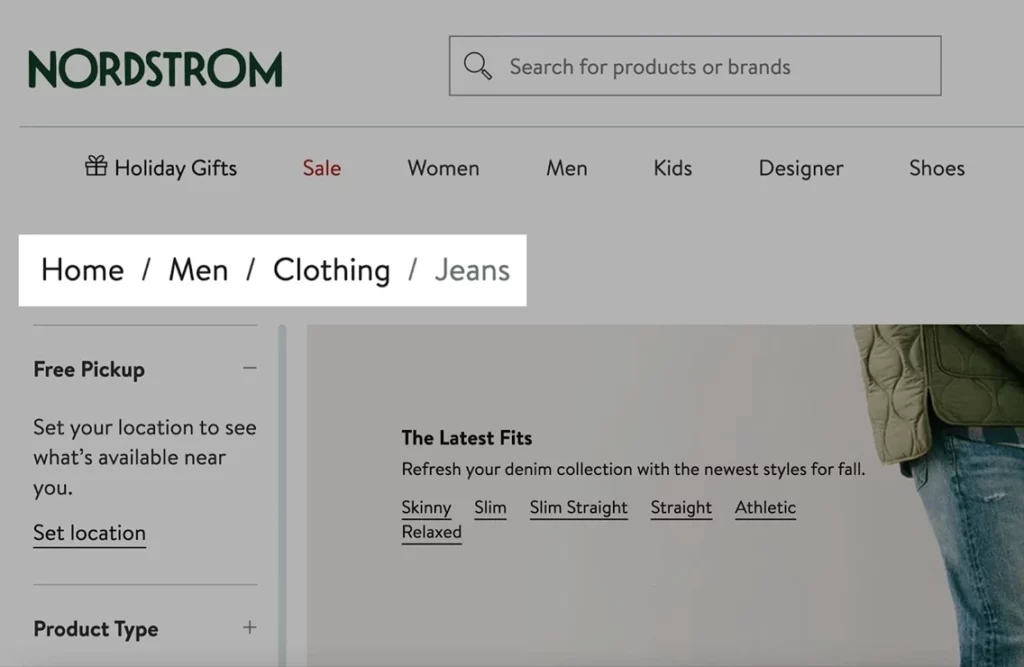
The Role of Internal Links in SEO
Internal links are not just pathways within your website; they are powerful tools that shape the user experience and bolster your SEO efforts.
- Boosts Page Authority
Internal links distribute “link equity” across your website. Pages with higher link equity often secure better positions in search engine results pages (SERPs).
- Enhances Indexation
Linking your website pages together is an effective way to help search engines crawl your website efficiently. Websites with a logical and comprehensive internal linking structure are indexed more efficiently, making your content more likely to appear in search results.
- Increase Conversions
Building a perfect internal linking structure helps you to get more conversions on your website. You can link individual posts to essential website pages, which enables you to get leads. That helps you to convert your initial customers to leads and customers.
- Improves User Engagement
Internal links keep users on your site longer by providing easy access to related content. This increases the user experience and signals to search engines that your site is relevant.
Best SEO Internal Linking Strategies
Here’s where you can find some of the best SEO internal linking strategies for boosting your website’s structure. Learn these tips to improve your site’s performance.
i. Audit Your Internal Linking Structure
Before making any changes, it’s essential to understand your current internal linking structure.
Use SuiteJar, the best content marketing tool, to optimize your website’s internal links. You will get insights about the number of internal and external links with the Website Auditor feature.
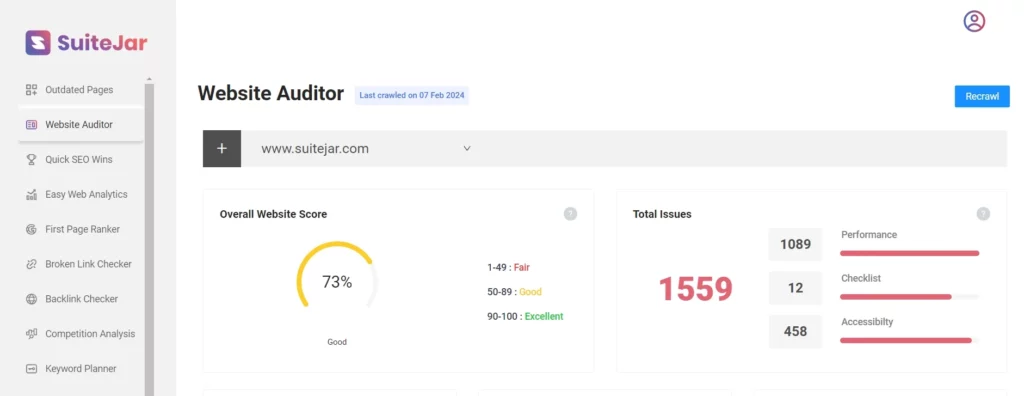
And you can get any issues within your internal links to enhance your site based on the suggestions provided.
Also, look for broken links on your website. You can enter your website link in the Broken Link Checker feature and then analyze the total number of broken link checkers and the errors they are causing.
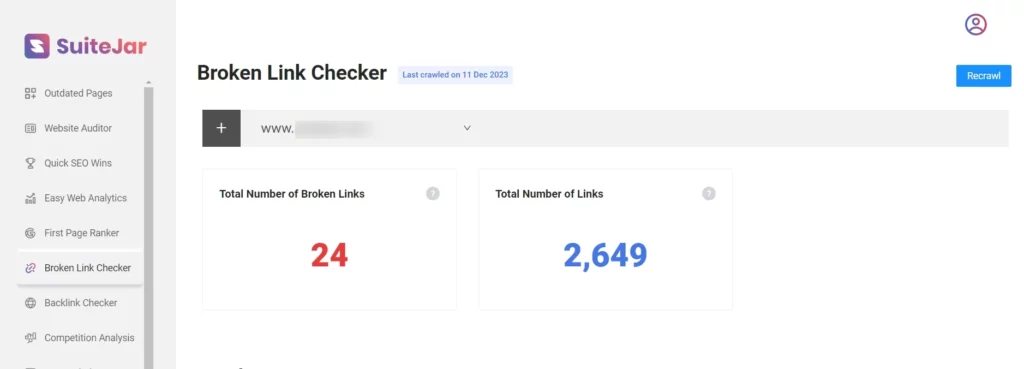
You can identify the broken link, its type, source URL, and server response. Feel free to download the sheet for a comprehensive view of the details.
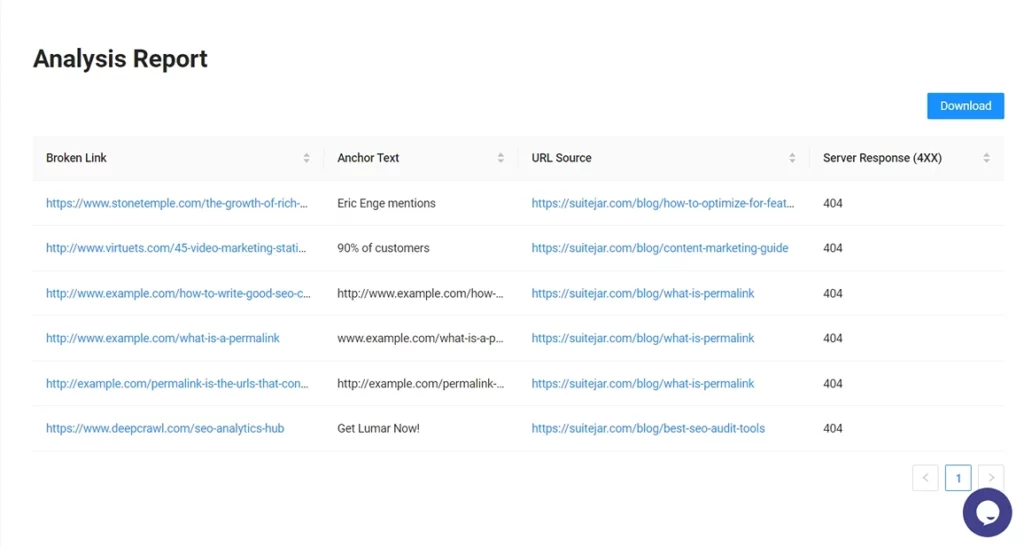
ii. Identify Your Pillar Pages and Topic Clusters
Pillar pages serve as comprehensive guides on your website, offering a detailed overview of a critical topic. They are fundamental to your content strategy.
Each pillar page should connect to more in-depth pages (cluster content) covering related subtopics or questions.
This layout aids users in navigating your content and assists search engines in understanding the connections between pages, bolstering your website’s authority on the subject. When creating topic clusters, ensure they align with your main topic.
For instance, if your pillar page discusses “SEO,” your clusters could touch on topics like “What is SEO?” or “Best SEO tools.”
You can use a keyword clustering tool to help structure your topic clusters. Use a keyword research tool like SuiteJar to find insights on related topics within the main subject.
With the selected location, you can enter your focus keyword into the keyword planner feature.
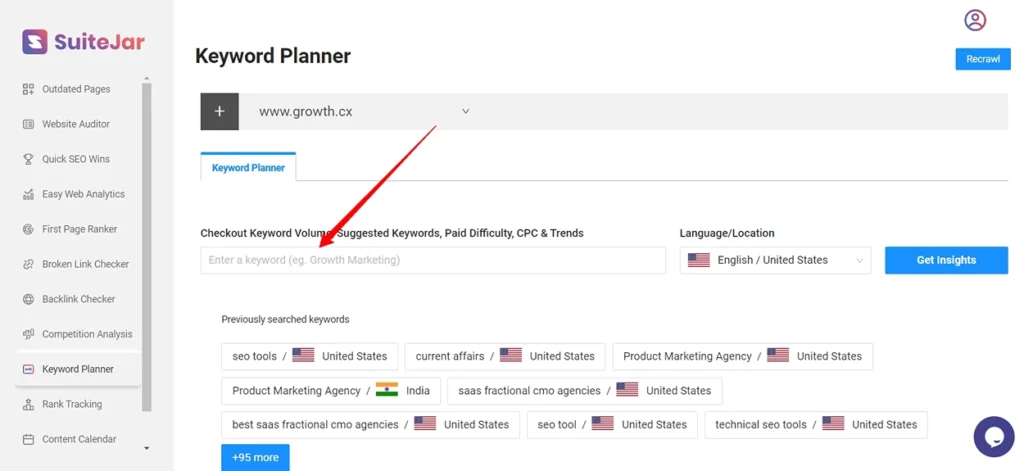
After clicking the ‘ get insights ‘ button, you will receive complete insights about the keyword you searched for.
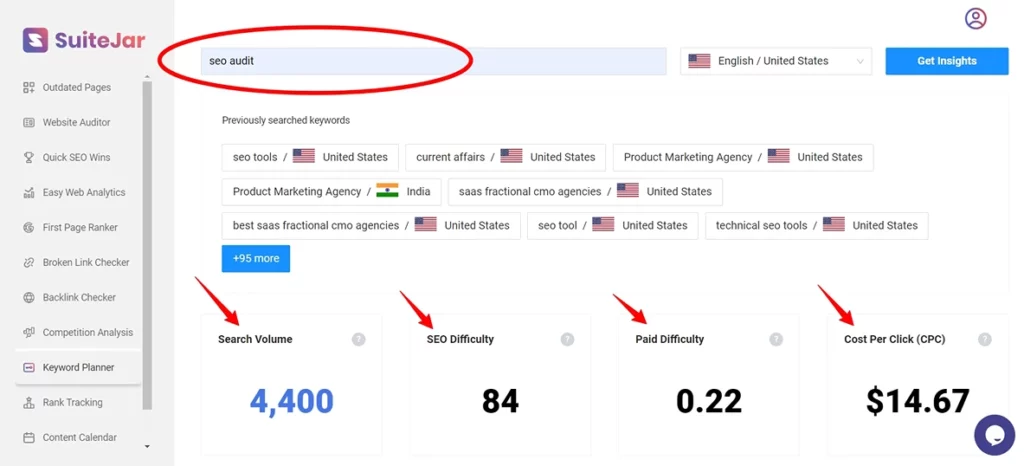
You will receive data on the keyword’s current search volume, SEO difficulty, paid difficulty, and CPC.
Also, you will be able to obtain information regarding the trends of this keyword, whether it is trending or not.
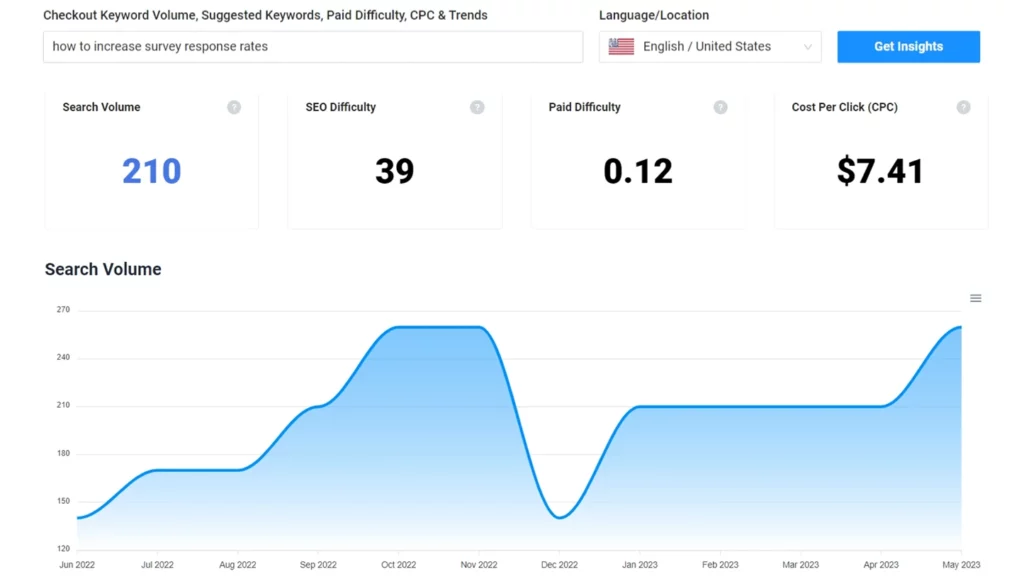
A list of suggested cluster keywords related to the type of keyword you entered will be provided. Accordingly, you can create keyword clusters based on the data provided.
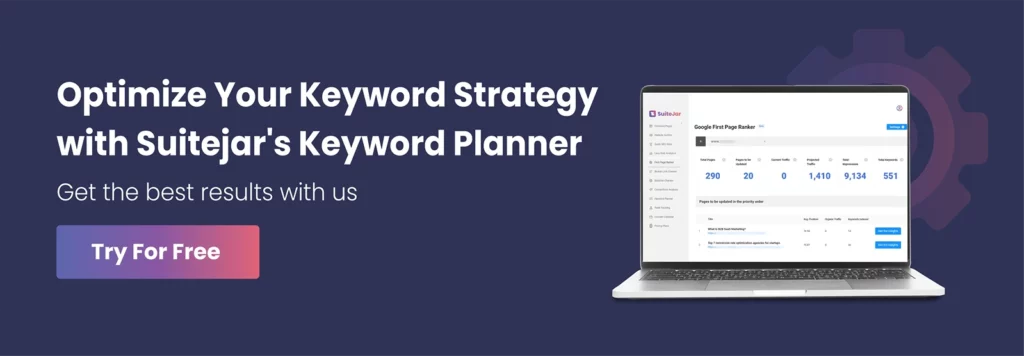
iii. Use Strategic Anchor Text
Anchor text is called the clickable text part of a hyperlink.
Using descriptive, keyword-rich anchor text helps search engines and your users understand what the linked page is about.
To optimize your content, strategically select words that indicate your target page topics. Ensure your anchor text is high quality to aid search engines and users understand the content before clicking.
- Be Descriptive: Use anchor text that accurately describes the linked page’s content.
- Avoid Repetition: Vary your anchor text to prevent any appearance of manipulation.
- Keep It Natural: Ensure the anchor text fits naturally within the context of your content.
You avoid using these phrases like “click here” or “learn more.” Instead, use anchor texts that give users a clear idea of what to expect on the linked page.
iv. Link Deep
Deep linking involves directing users to specific internal pages located multiple levels deep within your website’s structure rather than solely focusing on the homepage or top-level pages. Adopting this approach allows you to spread link authority evenly throughout your site and draw attention to in-depth, valuable content that might go unnoticed.
A common error many marketers make is linking the ‘Contact Us’ page as a call to action after their posts. While not strictly prohibited, it is advisable to avoid this practice unless necessary.
Since the homepage already includes these links in its primary navigation, refrain from duplicating them and instead prioritize linking to deeper-level pages within your site’s architecture.
v. Be Reasonable With Internal Links Used
You don’t need too many internal links on your website; it should align reasonably with the content length. Aim to include 5-6 internal links per post based on size. For instance, in a 1500-word blog, 5-6 internal links are adequate. Avoid overcrowding your article with links to maintain clarity and quality.
Common Mistakes to Avoid in Internal Link Building
When implementing an SEO internal linking strategy, it’s important to be look into some common mistakes. Take a look at these:
1. Too Many On-Page Links
Suppose you add too many links to your web page, that makes the page spammy and cluttered. So, overdoing links makes it harder for search engines to understand the site structure. This makes it difficult for Google to crawl and index your website, leading to a decrease in organic traffic.
2. Misuse Of Anchor Text
Proper anchor text needs to be clarified for your internal linking. You can add relevant and descriptive anchor text that can improve the UX of your website. This helps to make it easier for search engines to understand what web pages are about and their relation. Also filling your anchor text with too many keywords makes it artificial and spammy
- Adding ‘click here’ or ‘read more‘ didn’t give users a clear idea about the webpage.
- If you are adding the anchor text grammatically incorrect, just including the keyword won’t do you any favor.
- Also if you add only the links with no anchor text, that makes search engines to harder to understand what the target page is about.
3. Linking Irrelevant Pages
Linking to pages that are not related can affect user experience and negatively impact your site’s SEO. If you’re writing a blog post about SEO best practices, linking to a page about company news or unrelated product information can confuse readers and reduce the effectiveness of your internal links.
Always link to pages that are relevant to the content and context of your current page. This not only helps users find related information but also signals to search engines that your site is well-organized and authoritative on specific topics.
4. Not Updating Old Content with New Links
As you change or optimize your website, you must update it with links to new pages. If you do not pay any attention to change, you will have many problems with your website internal links. So regularly auditing your website helps correct these mistakes. You can then identify opportunities for adding internal links to new articles, blogs, or other product or service pages.
Conclusion
Linking internally is essential to boost your site’s performance in search engines, but it must be done correctly. Keep these SEO internal linking strategies in mind to ensure your website’s internal linking strategy is effective.
Consider investing in an affordable SEO tool for accurate data analysis, and remember to conduct regular site audits using website audit tools to monitor your links.
Also Read: Best SEO Audit Tools in 202
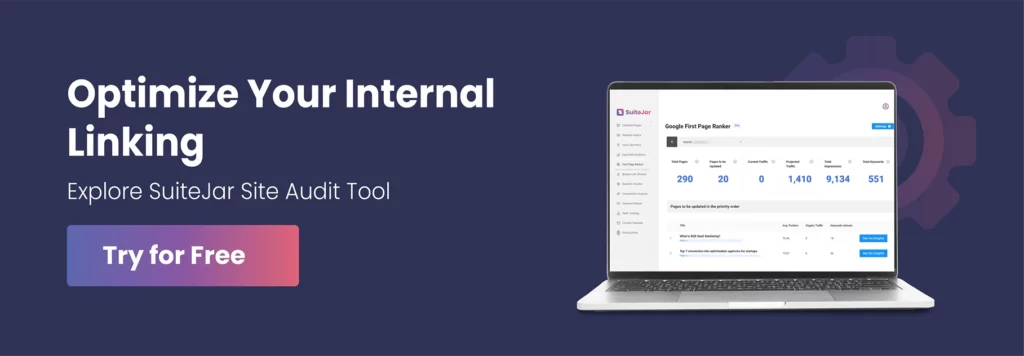
FAQs
1. What are internal and external links?
Internal links connect one web page to another on the same website. External links are hyperlinks that point from a page on one website to a page on another website.
2. What is called internal linking in SEO?
Internal linking helps in creating hyperlinks within your site that connect different pages of your website. This helps the users with the site’s usability and guides the search engines through the site’s complete structure.
3. How many internal links are good for SEO?
There is no fixed number of internal links, which is perfect for SEO. A good practice is to include enough links to enhance UX without overloading the page. A balance of 3-5 internal links per page is a good approach, but the actual number can vary depending on the depth of the content.
